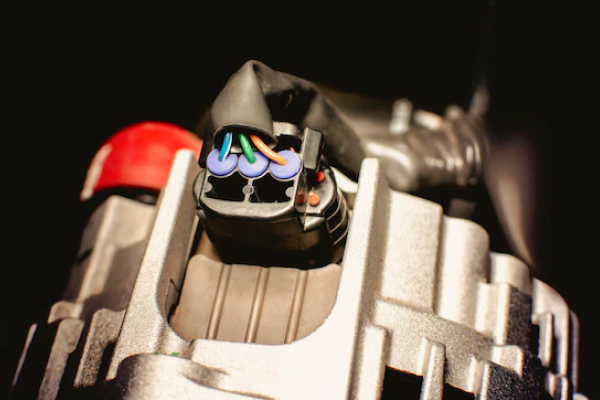Guide on how to test alternator without multimeter
Do you know how to test alternator without multimeter?
A lot of people don’t, and that’s why we’ve put together this guide. It’s essential to test your alternator regularly, so you can catch any problems before they become more significant.
With this guide, you’ll be able to test your alternator (a.k.a. starter motor) like a pro – in no time. You’ll never have to worry about being stranded on the side of the road again.
It’s also a good idea to test the charging system regularly, even if you don’t suspect any problems. This will help you catch any issues before they cause severe damage to your engine.

How To test the charging system
First, turn off the car engine. Then, connect the positive lead of the multimeter to the positive terminal on the battery and the negative lead of the multimeter to the negative cable on the battery. If the battery voltage reading is above 12 volts, then the charging system is working correctly. If it’s below 12 volts, there is a problem with this particular system, which needs to be repaired.
Testing your alternator regularly is an essential part of keeping your car in good shape. With this guide, you can easily do it yourself – and save yourself a lot of money in the long run.
What is an alternator, and what does it do

An alternator is a device that generates alternating current (AC) by transforming mechanical (chemical) energy into electrical energy. It is used in vehicles to charge the battery and power the electrical system, like the sound system when the engine is running. Alternators are also found in portable generators and large industrial facilities.
How do I know if my alternator is bad?
Bad alternators can cause various problems with your car, including engine stalling, dim or flickering lights, dead batteries, and strange noises (squealing sound or screeching sound). If you suspect your alternator is going bad, have it checked by a professional as soon as possible.
What are some common symptoms of a bad alternator?
Some common symptoms of a bad alternator include:
- Engine stalling or engine failure
- Dead battery
- Dim or flickering lights
- Strange noises coming from the engine
- The car’s engine or power won’t start
Can I replace my own alternator?

You can replace your own alternator, but it’s a complex job that requires special tools and knowledge. If you’re uncomfortable doing it yourself, take your car to a qualified mechanic or alternator specialist.
How long does an alternator last?
Most alternators will last for about 100,000 car run miles, but this can vary depending on the make and model of your vehicle, as well as driving habits.
What are some common issues that cause alternator problems?
Some common issues that can cause alternator problems include:
Worn-out bearings: The bearings in the alternator can wear out over time, causing the alternator to fail.
Loose pulleys: The pulleys that drive the alternator can become loose, making the alternator work harder and eventually overheat.
Failed diode: A failed diode in the alternator can cause it to generate less power and eventually fail.
How do I prevent alternator problems?
To prevent alternator problems, check your car’s electrical system regularly by a qualified mechanic or alternator specialist. Also, be sure to keep an eye on the condition of your alternator’s belt and pulleys and have them replaced if they show signs of wear.

How to test alternator with multimeter
First, disconnect the negative battery cable to test your alternator with a multimeter. Next, locate the alternator’s output terminal and attach the red lead of your multimeter to it. Finally, start the engine and rev it up to around 2,000 RPM. The resulting battery voltage reading should be between 13.5 and 14.5 volts. If it’s outside of that range, your alternator may have an issue.
You can also test the alternator’s output while under load to get a more accurate reading. To do this, turn on all of the car’s electrical accessories in your vehicle (headlights, radio, air conditioning, etc.) and then rev the engine up to 2,000 RPM. The instrument panel resulting ampere or voltage gauge reading should be between 11.5 and 12.5 volts. If it’s outside of that range, your alternator may have an issue.
If you think there may be an issue with your alternator, it’s best to have it checked out by a professional. Alternators are relatively inexpensive to replace, so it’s usually not worth trying to fix them yourself.
How to test alternator without multimeter
To test your alternator without a multimeter, you’ll need to disconnect the negative battery terminal first. Once that’s done, start the car’s engine and let it run for a few minutes. Then, turn on all of the lights in your car, including the headlights, taillights, and interior lights. Finally, rev the engine and see how bright the lights get. If they dim significantly, your car alternator will likely not work correctly.

What are the consequences of not testing your alternator
If you don’t test your alternator, it could fail and leave you stranded. Alternators are responsible for charging the battery, so if it fails, your car will likely die. Additionally, a failed alternator can damage other parts of your electrical load and system. Testing your alternator regularly can help you avoid these consequences.
Alternatives to a multimeter for those who don’t have one
If you don’t have a multimeter, there are other ways to measure AC voltage and DC voltage current. You can use an ammeter for AC current measurement and a voltmeter for DC current measurement. There are also clamp meters that can measure AC and DC current. Clamp meters work by clamping around a conductor, such as a wire, and then measuring the current flowing through the conductor.
Another option is to use a current probe. Current probes are devices placed around a conductor to measure the current flowing through it. Current probes can be used to measure both AC and Direct Current.
Finally, you can also use an oscilloscope to measure AC and DC current. Oscilloscopes are devices that measure the voltage of a signal over time. Oscilloscopes can be used to measure both AC and DC current.
Tips for prolonging the life of your alternator
1. Keep the car’s battery charged – A fully-charged battery puts less strain on the alternator and helps it last longer. Keep your battery topped up by regularly checking the water level and charging it when necessary.
2. Drive carefully – Avoiding hard acceleration, sudden braking, and excessive speeds will all help reduce wear and tear on your alternator.
3. Keep the alternator cool – An overheated alternator can shorten its lifespan. If your vehicle has an external fan, ensure it works correctly and keeps the alternator cool.
4. Check for loose belts – Loose belts can cause the alternator to work harder than necessary, leading to premature wear. Check all the belts in your vehicle regularly and tighten or replace them as needed.
5. Have the alternator checked regularly – Professional advice can spot potential problems before they cause serious damage. Having your alternator checked every few years can help ensure it lasts for its entire lifespan.
Following these tips can help prolong the life of your alternator and avoid costly repairs or replacements down the road. Be sure to maintain regular maintenance and checkups to ensure your car stays in top shape.
Alternator replacement cost
Replacing your car’s alternator can be a costly repair. If you catch the problem early enough, it may only cost you around $100-$400 to replace the alternator. Symptoms of a failing alternator include dim lights, trouble starting your car, and strange sounds (like a squealing or screeching sound) from the engine. If you notice any of these problems, you must take your car to a mechanic as soon as possible to have the alternator checked.
While replacing your car’s alternator may be expensive, it’s nothing compared to the cost of a new engine. If your alternator fails and you don’t catch the problem in time, your engine could overheat and suffer serious damage. Replacing an engine can cost upwards of $4,000, so it’s worth it to get your alternator replaced before it fails.
FAQs about alternators
How do I test my alternator manually?
To test your alternator, you’ll need a voltmeter, a multimeter, and a few other tools. First, disconnect the negative battery cable. Next, locate the voltage regulator on the alternator. Using the voltmeter, check the field terminal voltage. It should be between 0.5 and 1.5 volts. If it’s not, the alternator is defective.
Now, connect the multimeter to the output terminal on the alternator. The reading should be between 13.5 and 14.5 volts. If it’s not, the alternator is defective. Finally, check the drive belt for tension and wear. If it’s loose or damaged, the alternator won’t work properly.
What is the easiest way to test an alternator?
To test an alternator, you’ll need a voltmeter. First, jump-start the engine and let it run for a few minutes. Then turn off all the accessories (like air conditioning or air conditioner) and turn the ignition off. With the engine off, disconnect the negative terminal of the battery. Touch the voltmeter’s red lead to the battery’s positive cable and the black lead to the negative terminal. If the voltmeter test reads more than 12.6 volts, the alternator is working properly. If the alternator passes the voltmeter test, which reads less than 12.6 volts, the alternator is not charging the battery and needs to be replaced.
Can you check an alternator by disconnecting the battery?
You cannot check an alternator by disconnecting the car battery terminals.
Importance of alternator in vehicle
The alternator is one of the most critical parts of a vehicle’s electrical system, as it provides power to the car battery and keeps the engine running and its electrical device. Without an alternator, a car would not be able to start or run for very long. The good alternator is responsible for charging the battery and powering all of the electrical components in the car, such as the headlights, radio, and windshield wipers. If the alternator fails, the car will not have enough power to run and eventually die.
How to test alternator without starting car
To perform the car’s alternator tests without starting the car, you’ll need a voltmeter, a wrench, and a friend. First, connect the voltmeter to the battery terminals. Next, ask your friend to turn on the headlights. If the battery voltage drops below 12 volts, your alternator is not working properly. Finally, use the wrench to disconnect the negative cable battery. If the voltage drop is still present, then your alternator needs to be replaced.
How to test alternator with screwdriver
If you suspect your alternator is going bad, you can test it with a screwdriver. First, disconnect the battery cables. Then, touch the screwdriver’s tip to the alternator’s positive terminal. If the engine is running, you should see a spark. If not, then the alternator is most likely failing or becoming a faulty alternator and will need to be replaced. By doing this, you will know if the alternator has an internal magnetic field.

How to test alternator with battery
You can test your alternator with a battery in a few ways. One way is to use a voltmeter to measure the alternator’s voltage output. Another way is to use an ammeter to measure the alternator’s current output. Lastly, you can use a multimeter to measure the alternator’s voltage and current output.











Leave a Reply